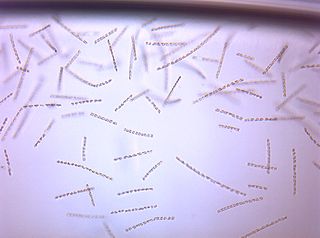May 29 is the 149th day of the year in the Gregorian calendar; 216 days remain until the end of the year.
September 19 is the 262nd day of the year in the Gregorian calendar; 103 days remain until the end of the year.
The Chicago Cubs baseball club is an original member of the National League, established in 1874 or 1870. Here is a list of players who appeared in at least one regular season game beginning 1874.

Chaetoceros is probably the largest genus of marine planktonic diatoms with approximately 400 species described, although many of these descriptions are no longer valid. It is often very difficult to distinguish between different Chaetoceros species. Several attempts have been made to restructure this large genus into subgenera and this work is still in progress. However, most of the effort to describe species has been focused in boreal areas, and the genus is cosmopolitan, so there are probably many tropical species still undescribed. Some species are known from the fossil record, from the Quaternary of Sweden. It is the type genus of its family.
Craticula is a genus of diatom that lies on or in the top layers of sediments in the freshwater to brackish water environments it inhabits. In addition to frustule morphology the genus differs from closely related species by its sexual reproduction and movement in response to light.

Amphora is a major genus of marine and freshwater diatoms. With over 1000 species, it is one of the largest genera of diatoms. These diatoms are recognized by their strongly dorsiventral frustules, which means that their ridges lie close to the ventral margin of the valve, and their girdle is much wider on the dorsal side.
Members of the Bavarian Maximilian Order for Science and Art, awarded to acknowledge and reward excellent and outstanding achievements in the fields of science and art. It is based in Bavaria, Germany.

A protist is any eukaryotic organism that is not an animal, plant, or fungus. The protists do not form a natural group, or clade, since they exclude certain eukaryotes with whom they share a common ancestor; but, like algae or invertebrates, the grouping is used for convenience. In some systems of biological classification, such as the popular five-kingdom scheme proposed by Robert Whittaker in 1969, the protists make up a kingdom called Protista, composed of "organisms which are unicellular or unicellular-colonial and which form no tissues".

The Cymbellaceae are a diatom family in the order Cymbellales.
Stauroneis is a genus of diatoms (Bacillariophyta) with species that occur in fresh and marine water.

Gomphonema is a genus of diatoms belonging to the family Gomphonemataceae.

Melosira is a genus of diatoms belonging to the family Melosiraceae.






